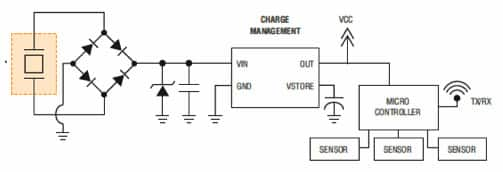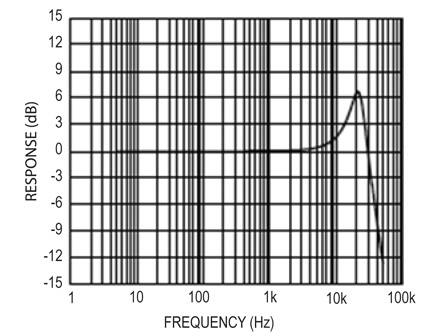Vibration Sensor Applications and Solutions
投稿人:电子产品
2013-01-10
Vibration causes havoc in many applications. From machine shafts and bearings to hard disk performance, vibration causes machine damage, early replacement, low performance, and inflicts a major hit on accuracy.
Using vibration analysis as a tool to determine the specific cause and location of machinery problems can expedite repairs and minimize costs. Vibration sensors can measure and analyze displacement, linear velocity, and acceleration. These parameters are mathematically related and can be derived from a variety of sensors. Selection of a sensor proportional to displacement, velocity, or acceleration depends on the frequencies of interest and the signal levels involved.
Three major factors differentiate vibration sensors: the natural frequency, damping coefficient, and scale factor. The scale factor relates the output to an acceleration input and is linked to sensitivity. Together, the natural frequency and damping coefficient determine the accuracy level of a vibration sensor. In a system consisting of a spring and attached mass, if you were to pull the mass back away from equilibrium and release the mass, the mass would vibrate forward (past the equilibrium) and backward until it came to rest. The friction that brings the mass to rest is defined by the damping coefficient, and the rate at which the mass vibrates forward and backward is its natural frequency.
The two basic piezoelectric materials used in vibration sensors today are synthetic piezoelectric ceramics and quartz. In a piezoelectric sensor or accelerometer, the sensing element is a crystal that emits a charge when subjected to compression. The crystal is bonded to a mass so that when it is subjected to a “g” force, the mass compresses the crystal and a signal is emitted. The signal value is relative to the force imposed.
The crystals are attached between a center post and a seismic mass. A compression ring or stud applies a pre-load force to the element assembly to ensure a rigid structure and linear behavior. Under acceleration, the mass causes shear stress to the sensing crystals, resulting in a proportional electrical output by the piezoelectric material. The output is collected by electrodes and transmitted by lightweight lead wires to other circuitry or directly to connectors.
This small acceleration signal can be amplified for acceleration measurements or converted within the sensor into a velocity or displacement signal. Most piezoelectric sensors used in vibration monitoring today contain internal amplifiers. An op amp can be used to interface these sensors to an A/D converter, either discrete or on a microcontroller. Be careful to choose a high-input-impedance op amp to minimize current.
Once recorded, vibration data can be analyzed for an immediate diagnosis or saved for later or deeper evaluation, for example, to record trends and history involved in a machine’s health, for asset protection in financial and retail environments, or to differentiate between ambient vibration and real attacks in such applications as ATMs, vending, and ticket machines.
The sensing element can be housed to withstand whatever environmental conditions exist. The rugged, solid-state construction of industrial piezoelectric sensors enables them to operate under most harsh environmental conditions. They are unaffected by dirt, oil, and most chemical atmospheres. They perform well over a wide temperature range and resist damage due to severe shocks.
Piezoceramics
While both quartz and ceramics are adequate for successful vibration sensor design, differences in their properties allow for design flexibility. For example, natural piezoelectric quartz has lower charge sensitivity and exhibits a higher noise floor when compared to the modern "tailored" piezoceramic materials. Nevertheless, most vibration sensor manufacturers now use piezoceramic materials developed specifically for sensor applications. Special formulations yield optimized characteristics to provide accurate data in extreme operating environments. The exceptionally high output sensitivity of piezoceramic material allows the design of sensors with increased frequency response when compared to quartz.
Piezoceramic vibration sensors can be used in shock measurements (explosions and failure tests), high-frequency measurements, and slower low-frequency vibration measurements. This is shown by their higher than average natural frequency. However, this sensor typically has outputs in the millivolt range and requires a high-input-impedance, low-noise detector to interpret voltages from its piezoelectric crystal.
Another important application is vibration energy harvesting. This converts otherwise wasted energy from mechanical vibrations into useable electrical energy. The Midé Volture vibration energy harvester (Figure 1), for example, uses normally brittle piezoelectric materials and incorporates a piezoelectric transducer packaging technology. The Volture packages piezoelectric materials in a protective skin with pre-attached electrical leads and no soldered wires. It features a low profile, can be used in harsh environments, is available in multiple sizes to match numerous applications, and integrates directly with COTS products. Applications include health monitoring network sensors, condition-based maintenance sensors, wireless HVAC sensors, mobile asset tracking, tire pressure and oil and gas sensors, air, land and sea vehicle sensors, and battery and hard wired power replacements.

The performance of accelerometers for these applications is increasing dramatically. For example, the ADXL001 by Analog Devices, Inc. (Figure 2) provides high performance and wide bandwidth for industrial monitoring, medical instrumentation, sports diagnostic equipment, and military applications where wide bandwidth, small form factor, low power, and high performance are critical.

Features of the ADXL001 include ±70 g, ±250 g, and ±500 g wideband range availability, 22 kHz resonant frequency structure, high linearity at 0.2% of full scale, low noise at 4 mg/√Hz, sensitive axis in the plane of the chip, frequency response down to DC, full differential signal processing, and a high resistance to EMI/RFI. It also features low power consumption (2.5 mA typical), and is housed in an 8-terminal, hermetic ceramic, LCC package.
Another interesting part is the Measurement Specialties 0-1002794-0 cantilever piezo film sensor. This sensor can be hard mounted to a surface, floating in an axis of inertia, or mass loaded to pre-bias and calibrate. The output voltage swings can directly trip a FET or CMOS input, and a multiaxis response can be obtained by offsetting the mass center. As the piezo film is displaced from the mechanical neutral axis, bending creates very high strain within the piezopolymer and therefore high voltages are generated. When the assembly is deflected by direct contact, the device acts as a flexible "switch", and the generated output is sufficient to trigger MOSFET or CMOS stages directly.
If the assembly is supported by its contacts and left to vibrate "in free space" (with the inertia of the clamped/free beam creating bending stress), the device will behave as an accelerometer or vibration sensor. Adding mass, or altering the free length of the element by clamping, can change the resonant frequency and sensitivity of the sensor to suit specific applications.
Future uses of vibration sensors may well run far afield of today’s applications. At NASA’s Ames research facility, for example, engineers are studying fiber optic pressure and vibration sensors. In this research, sensors use the phase modulation of light traveling through an optical fiber exposed to external fields. The phase modulation is retrieved and processed to determine a specific field characteristic, relaying data at high speeds through the fiber. External disturbances such as strain, pressure, temperature, acoustics and vibration cause measureable phase changes in the light signal that are measured by the fiber’s electrical unit. Potential commercial uses include a medical application such as an artificial voice box, where a fiber optic acoustic sensor is implanted to amplify the vibrations in a patient’s throat, eliminating a handheld throat device.
Summary
Global competition and pressure on corporate performance makes productivity a primary concern for any business. A good means, then, of reducing the overall operating cost of industrial plants – by acting as an indicator of machinery health – is a machinery vibration monitoring program. Used to spot imbalances in rotating components, alignment problems of machine shafts, worn components, or loose bearings, vibration analysis can reveal all of these telltale factors of impending machinery breakdown.
With today’s vibration sensors, data acquisition and analysis technologies, vibration analysis is less expensive and much more mainstream than in the past. And at the heart of the vibration monitoring system is a piezoceramic sensor. This article has examined the basic features and benefits of this sensor and presented a representative sampling of currently available parts. For more information on the products discussed use the links provided to access product information pages on the DigiKey website.
免责声明:各个作者和/或论坛参与者在本网站发表的观点、看法和意见不代表 DigiKey 的观点、看法和意见,也不代表 DigiKey 官方政策。










 中国
中国